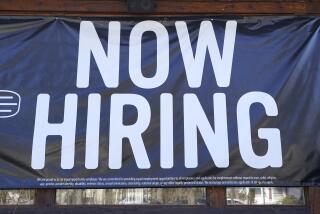Manufacturing Gauge Hints at Slower Growth
- Share via
NEW YORK — U.S. factories cranked out goods at a much slower pace than expected in December, but spending on construction edged up to a record in November, according to reports released Tuesday.
The cooling in the manufacturing sector -- one of the economy’s strongest performers -- suggested more subdued economic growth ahead and little need for more rate hikes from the Federal Reserve.
The minutes from the Fed’s last meeting Dec. 13, released Tuesday, showed policymakers aimed to signal that a 1 1/2 -year rate hike campaign probably was near its end.
“Given the information now in hand, the number of additional firming steps required probably would not be large,” the minutes said.
The Institute for Supply Management said its index of national factory activity fell to 54.2 in December from 58.1 in November after a three-month boost to activity after hurricanes Katrina and Rita. The index came in well below economists’ forecast for an easing to 57.5, although it was still above 50, denoting expansion.
“The decline in the ISM index represents a return to normal for the manufacturing sector,” said Daniel Meckstroth, chief economist at the Manufacturers Alliance/MAPI.
“Hurricanes Katrina and Rita disrupted transportation networks and supply chains in manufacturing at a time when inventories were already lean, setting off a scramble for materials,” Meckstroth said. “By year-end, manufacturers got caught up.”
One silver lining that accompanied the decline in new orders and production was a similar fall in inflation pressures in the manufacturing report. The prices-paid component declined to 63 from 74, showing that fewer producers reported an increase in the prices they paid for raw materials.
The manufacturing index is one of the key monthly economic indicators and has been closely watched by Fed officials.
Separate figures out Tuesday showed vigorous activity continued in the construction sector near the end of the year, striking a record as both public and private building hit new highs in November.
Construction spending increased 0.2% to a seasonally adjusted annual rate of $1.15 trillion, the Commerce Department reported. Economists had expected a 0.6% increase.
Much of the strength came in private nonresidential construction, while the housing component stalled for the first time since June.
“The weakness was primarily in the residential area,” said Gary Thayer, chief economist at A.G. Edwards & Sons. “That’s consistent with the other data we’ve seen recently that suggest that the housing market is cooling off.”
Private residential construction spending fell $122 million, leaving it unchanged on a percentage basis from October. That marked the first time since June 2005 that private residential construction spending has not increased and confirmed the picture that the five-year rally in the U.S. housing market has started to slow.
Economists said the report suggested that rebuilding after Hurricane Katrina was not proceeding as quickly as expected.
The post-hurricane effect was also evident in the manufacturing report.
“This is more of a return to status quo and really represents where the manufacturing sector might have been had we not had the hurricane factor,” Norbert Ore, the chairman of the institute’s business survey committee, told reporters in a conference call.
More to Read
Inside the business of entertainment
The Wide Shot brings you news, analysis and insights on everything from streaming wars to production — and what it all means for the future.
You may occasionally receive promotional content from the Los Angeles Times.










